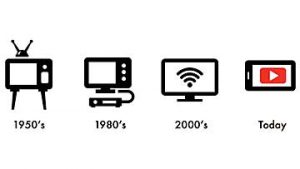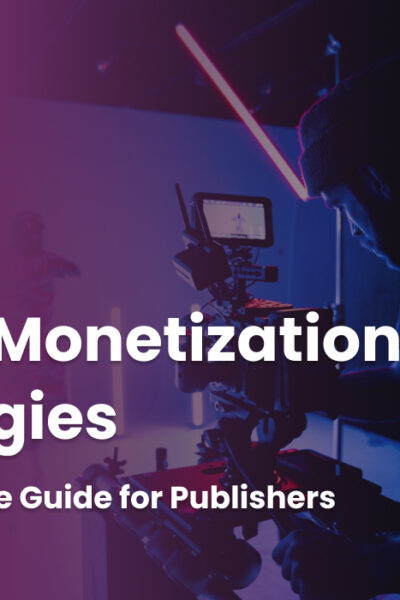Marketing forums are packed with tips about online video advertising, but some user-provided suggestions are inaccurate or misleading. Our detailed guide to online video advertising makes it a cinch to filter through the conflicting information found on the web so you can implement successful marketing practices.
Remember that videos can be used in two major ways — to provide engaging, relationship-building content for the reader and to advertise your goods or services. In many cases, you can integrate both goals into the same video by providing helpful or entertaining content that mentions or even features your product. For example, if you’re marketing a type of hair product, you could promote it with videos that concentrate on how-to tutorials for various hairstyles. Such videos might incorporate the hair product into the how-to without pushing it in a formal advertising method.
What is Video Advertising?
Video advertising is when you promote goods or services via short video clips. Some marketers also use video advertising to establish or revamp an identity, raise awareness about an issue or share details about a contest.
Unless you have pop-up blockers enabled, you’ve probably seen the ads that appear during a news story, online shopping session or YouTube video. You might have also noticed short ads on grocery store registers, in-store blood pressure kiosks or the tablets in medical exam rooms. These are all popular examples of video advertising that can be used to complement your existing reader-based content campaigns.
Some potential customers retain data best by seeing photos or listening to a verbal explanation, while others prefer to learn via written text. Video advertisements typically express information using sound and images, but some also incorporate text. This combination appeals to both visual and aural learners, making it easy to target multiple audiences with a single video.
Video ads are appropriate for businesses of all sizes, whether you’re a solopreneur who wants to cultivate a distinct digital footprint or an advertising executive at a company that rakes in billions of dollars each year. The length, type and format you choose for each video clip depends on your marketing goals. Other important factors include the platform you choose to advertise on and a number of funds you can dedicate to video marketing.
There are different types of video advertising, which we’ll discuss later in this guide. We’ll spend a lot of time talking about online video advertising because it’s a blanket term for multiple types of video advertising, including mobile video advertising, social video advertising, and YouTube video advertising.
Video Advertising statistics
Many companies already promote ideas or products via short clips online, and you can expect to see more businesses jump on the video bandwagon over the next few years. On average, marketers allocate approximately 20 percent of their budgets toward online video advertising — but that number is growing. Nearly 2 out of 3 of marketers plan to increase the funds spent on online video advertising over the next 12 months, says eMarketer. These marketing goals make sense when you consider the statistics related to internet use. Approximately 21 percent of American adults admit that they’re online “almost constantly,” and 42 percent confess to logging on multiple times per day. According to Pew Research Center, nearly 3 out of 4 adults get online daily.
If you’re targeting a younger demographic, we’ve got great news for you: Teens spend a ton of time online, too. The average teen racks up 9 hours of screen time each day, and preteens spend about 6 hours engaging in digital content. Youth from low-income families spend even more time online, logging in 90+ more daily minutes than kids from families with higher incomes.
Many marketers mistakenly assume that the younger generation dominates the online scene, but frequent internet use isn’t limited to Millennials, teens, and tweens. Pew Research Center reveals that 12 percent of adults who fall between the ages of 50 to 64 say they’re constantly online, while 6 percent of adults above the age of 65 reports the same. The internet provides information and entertainment for all races, genders and income levels, so it’s a safe bet to assume your online video has an excellent chance of reaching viewers from your target demographic.
You can increase your chances of reaching target demographics with your video marketing efforts by creating content that doesn’t just promote or advertise. Make sure you mix a healthy amount of engaging content into your videos so they are shared, liked and enjoyed by your audience. If you purchase ads on someone else’s video or channel, use A/B testing and programmatic tools to ensure your campaigns are running on content that engages with your audience.
Video Advertising online
Online video advertising refers to any type of video marketing that takes place online. You might find online video ads on the following types of websites:
- Social networking
- Shopping
- Bank
- Government
- Health and wellness
- Food and recipe
- YouTube
Many online ads are compatible with a variety of devices, including laptops, desktops, tablets, and smartphones. This lets you reach your audience no matter how they access the web.
Online video advertisements have an average click-through rate of 1.84 percent. If that figure sounds low, keep in mind that it’s currently the highest click-through rate associated with any form of digital marketing. Marketing Land reports that the projected combined revenue for online video advertisements launched during 2016 is a whopping $5 billion.
After hearing the benefits of digital video advertising, you might be wondering whether online video advertising is right for you — especially if you don’t own any fancy video equipment or know how to edit videos. The truth is, most viewers don’t need the highest quality video production to engage with your brand — instead, they want authenticity and creativity. If you’re going to invest in anything, we suggest spending on research and creative efforts, at least to start.
Examples of successful Video Advertising campaigns
One of the most successful digital publishing video campaigns isn’t an advertising campaign at all. It’s a highly awaited video slide deck published by industry expert Mary Meeker every year. The deck usually tops 200 slides and presents a wide range of information gathered from Meeker’s experience within her digital publishing company. The deck is known as the 2016 Internet Trends Report, and its audience is anyone involved in online marketing, advertising or eCommerce.
The reason Meeker’s yearly video generates so much buzz is that it is chock full of data that is useful and interesting to the target audience. She provides data that is actionable; statistics might not be what does it for your audience, but strong video marketing means finding the piece of information that makes your demographic sit up and take notice.
Another example of successful video advertising in a low-budget format comes from venture capitalist Mark Suster, who uses Snapchat to broadcast miniature lectures on starting a new business. The platform he uses is fun, inviting and has plenty of “cool” factor, and he keeps his deliveries short and punchy so his audience remains engaged.
On a more mainstream channel, short how-to videos are extremely popular with people of all ages. Consider the cooking videos that are shared constantly on Facebook. In less than 60 seconds, and with a pleasant or catchy background tune, viewers get the bare-bones information on how to make a Tiramisu or Buffalo chicken wings. The videos are colorful and eye-catching, and they always come with a link to the full recipe or tutorial online. Remember: while you want videos that entertain and engage, you also want people to click through to your pages or products.
Tips for creating your own videos
Talk to your viewers, not at them
Yeah, we realize that might seem tricky during an advertisement, but there are ways to make it happen. Ask your viewers questions to keep them engaged, even though you can’t hear their responses. Talk about things that are relevant to your target demographic, but don’t make assumptions about your viewers. Avoid phrases like “I know that you …” or “We’re sure that you …”.
Don’t overstay your welcome
Viewers get annoyed when ads are too long, even if they like what you’re promoting. If your goal is simply to raise awareness about a company or product, 15 seconds is plenty of time. Feel free to tack on an additional 15 seconds if you want, as reports show that 30-second ads typically have higher view-through rates than 15-second ads.
Make it interactive
Your ad might be amazing, but it doesn’t benefit your business without a call to action. Include a clickable link to your website or a featured deal so viewers know how to find you. If your website is under construction or you don’t have products to promote, include a link where viewers can enter their email addresses or take a quick survey. At the very least, include social media sharing buttons so viewers can tell friends and family about your business.
Mobile Video Advertising?
Mobile video advertising lets you come to your viewers instead of vice versa. You don’t need to wait for them to access the internet via a laptop or desktop when you create mobile-friendly advertisements.
WHY IS MOBILE VIDEO ADVERTISING IMPORTANT IF YOU’RE A MARKETER?
Launching digital advertisements carries multiple risks. You might post your ads in places where your target demographic can’t find them. Even if you do get your message in front of the right people, they might be busy, bored or irritated by your videos. That’s less likely to happen if you rely on mobile video advertising. Forbes reports that mobile viewers are typically more engaged in online activities than desktop or laptop viewers, so you don’t have to worry as much about fickle viewers abandoning your video for the next best thing. Nearly 70 percent of American adults own a mobile phone, and that percentage jumps to around 86 percent if you examine the habits of 18- to 29-year-olds. Approximately 80 percent of worldwide mobile data traffic comes from smartphones.
SOCIAL/INTERACTIVE VIDEO ADVERTISING
Social media sites let users interact with friends, family, and brands from the comfort of their sofas. Nearly 2 billion people belong to social media sites, and that figure has increased significantly over the last 5 years. The high volume of social media users makes social video advertising a common advertising choice for many marketers.
YOUTUBE/PREROLL VIDEO ADVERTISING
YouTube has more than one billion users, and the average viewing session for a mobile user exceeds 40 minutes. Preroll video ads are the advertisements that appear before YouTube videos, and each ad typically lasts for 10 to 15 seconds. These ads are popular with marketers because they have a high viewing rate. When users load videos, they typically watch the pre-roll ads because they want to see the videos they selected.
FACEBOOK VIDEO ADVERTISING
Facebook has 1.18 billion daily users, making it another great place for marketers to share digital advertisements. YouTube focuses more on a solo viewing experience, while users typically log onto Facebook to interact with family and friends. If you plan to advertise on Facebook, consider an interactive ad. An interactive video ad gives viewers control of the information they receive. Users can scroll over the video to select different options, or they can tap different parts of a touchscreen device. This enhances engagement by letting viewers create customized marketing plans tailored toward their interests.
NATIVE VIDEO ADVERTISING
Sometimes digital advertising is subtle. Native video advertising refers to ads that blend into a website’s regular content. You should use native video advertising if you suspect that in-your-face ads might offend your target demographic(s). Native videos give you a chance to build a relationship with viewers without coming across as spammy or distant. You can place ads between posts or insert a video on the right or left side of a web page.
Content from our partners
Facebook ads were addressed in the last section, but some marketers consider them a form of native advertising. For example, a video clip for a restaurant that appears in your feed as you’re watching food videos could be considered a native video ad.
PROGRAMMATIC VIDEO ADVERTISING
Nearly 70 percent of digital advertising budgets are devoted to programmatic video advertising, making it the most popular form of online video advertising. Marketers like programmatic video advertising because it delivers instant results. You don’t have to wait for the right audience to log on or try to figure out if you’re targeting the correct demographic.
YouTube is one platform that lets marketers experiment with programmatic video advertising. Programmatic video advertising is also a form of social video advertising.
TOP COMPANIES/PROVIDERS
Earlier in this guide, we told you that Facebook and YouTube are great places to advertise via video. This is because social networking sites have a high number of users, and it’s easy to target ads toward specific demographics. However, you can publish online video advertisements on nearly any site as long as the owner says it’s okay. Here are some well-known companies that help launch digital advertisements and connect businesses with viewers:
- BrightRoll
- HaxHax
- AdoTube
- Google Adsense
- Media.net
- Fidelity Media
Before choosing a company, consider the size of your marketing budget and whether you need help targeting a specific audience. Media.net is great for small business owners, Fidelity Media is popular with large businesses and Google Adsense works well for solopreneurs, medium-sized businesses or large companies.
Video Advertising trends
As the use of video marketing increases, you can expect to find ads on social media sites like Facebook, YouTube, and Snapchat. We’ve already discussed Facebook and YouTube earlier in this guide, but Snapchat is quickly making a name for itself in the digital advertising world.
There are more than 100 million Snapchat users, and more than 50 percethef them post or view content on a daily basis. Snapchat users view more than 2 billion more videos per day than Facebook users, and some advertisements receive as many as one million views. If you’re new to Snapchat, keep in mind that posts are only live for 24 hours, and you need to cap your advertisement at 10 seconds.
Another trend involves posting video clips on landing pages to increase customer engagement. Reports indicate that 88 percent of online visitors remain on a site longer if a video captures their attention. That gives you extra time to steer them toward high-quality products or get them to sign up for your webinar.
Digital video advertising is a practice that isn’t going away anytime soon, so it’s vital that you implement it into your marketing plan. Establish an impressive — and trustworthy — digital identity for your business with online video advertising.












